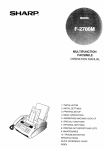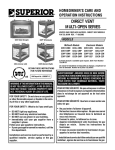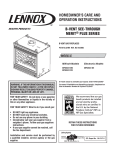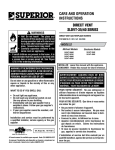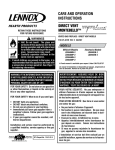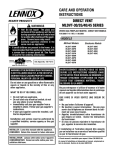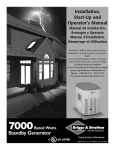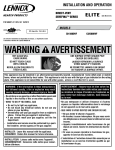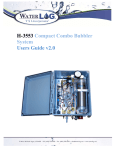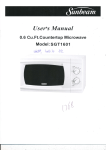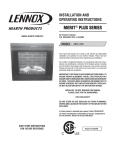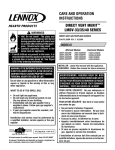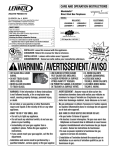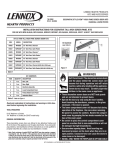Download direct vent multi-open elite® series
Transcript
HOMEOWNER'S CARE AND OPERATION INSTRUCTIONS DIRECT VENT MULTI-OPEN ELITE® SERIES WARNINGS • Hot! Do not touch! The glass and surfaces of this appliance will be hot during operation and will retain heat for a while after shutting off the appliance. Severe burns may result. • Carefully supervise children in the same room as appliance. • If small children are present in the home, it is recommended that this appliance be fitted with a screen door or screen panel kit. See Page 9 for ordering information. RETAIN THESE INSTRUCTIONS FOR FUTURE REFERENCE OTL Report No. 116-F-04-5 WARNING: IF THE INFORMATION IN THIS MANUAL IS NOT FOLLOWED EXACTLY, A FIRE OR EXPLOSION MAY RESULT CAUSING PROPERTY DAMAGE, PERSONAL INJURY OR LOSS OF LIFE. FOR YOUR SAFETY: Do not store or use gasoline or other flammable vapors or liquids in the vicinity of this or any other appliance. FOR YOUR SAFETY: What to do if you smell gas: VENTED GAS FIREPLACE HEATERS - DIRECT VENT MODELS P/N 875,022M REV. C 03/2007 MODELS Millivolt Models EDVSTNM EDVSTPM EDVPFNM EDVPFPM EDVCRNM EDVCRPM EDVCLNM EDVCLPM Electronic Models EDVSTNE EDVPFNE EDVCRNE EDVCLNE A French manual is available upon request. Order Form Number 875,022CF. Ce manuel d’installation est disponible en francais, simplement en faire la demande. Numéro de la pièce 875,022CF. AVERTISSEMENT: ASSUREZ-VOUS DE BIEN SUIVRE LES INSTRUCTIONS DONNÉ DANS CETTE NOTICE POUR RÉDUIRE AU MINIMUM LE RISQUE D'INCENDIE OU POUR ÉVITER TOUT DOMMAGE MATÉRIEL, TOUTE BLESSURE OU LA MORT. POUR VOTRE SÉCURITÉ: Ne pas entreposer ni utiliser d'essence ni d'autre vapeurs ou liquides inflammables dans le voisinage de cet appareil ou de tout autre appareil. POUR VOTRE SÉCURITÉ: Que faire si vous sentez une odeur de gaz: DO NOT light any appliance. DO NOT touch any electrical switches. DO NOT use any phone in your building. Immediately call your gas supplier from a neighbor’s phone. Follow your gas suppliers instructions. • If your gas supplier cannot be reached, call the fire department. • Ne pas tenter d'allumer d'appareil. • Ne touchez à aucun interrupteur. Ne pas vous servir des téléphones se trouvant dans le batiment où vous vous trouvez. • Evacuez la piéce, le bâtiment ou la zone. • Appelez immédiatement votre fournisseur de gaz depuis un voisin. Suivez les instructions du fournisseur. • Si vous ne pouvez rejoindre le fournisseur de gaz, appelez le service dos incendies. Installation and service must be performed by a qualified installer, service agency or the gas supplier. L'installation et service doit être exécuté par un qualifié installeur, agence de service ou le fournisseur de gaz. • • • • NOTE: DIAGRAMS & ILLUSTRATIONS NOT TO SCALE. 1 CONGRATULATIONS! In selecting this LENNOX Direct-Vent Gas Appliance you have chosen the finest and most dependable fireplace to be found anywhere. Its a beautiful, prestigious alternative to a wood burning fireplace. Welcome to a Family of tens of thousands of satisfied LENNOX Fireplace Owners. Please carefully read and follow all of the instructions found in this manual. Please pay special attention to the safety instructions provided in this manual. The Homeowner's Care and Operation Instructions included here will assure that you have many years of dependable and enjoyable service from your LENNOX product. TABLE OF CONTENTS Introduction ..................................... page 2 General Information ......................... page 2 Operation/Care of Your Appliance .... page 3 Variable Flame Adjustment .............. page 4 Glass Cleaning ................................. page 4 Maintenance .................................... page 4 Front Glass Enclosure Panel, Removal and Installation ............... page 4 Maintenance Schedule ..................... page 5 Burner Adjustments ......................... page 6 Flame Appearance and Sooting ....... page 6 Adjustment ...................................... page 6 Ceramic Panel, Log and Glowing Ember Placement ............. page 7 Millivolt Appliance Checkout ............ page 7 Electronic Appliance Checkout ......... page 8 Wiring Diagrams .............................. page 8 Warranty .......................................... page 8 Replacement Parts ........................... page 8 Product Reference Information ....... page 8 Accessory Components ................... page 9 Lighting Instructions – Millivolt ....... page 16 Lighting Instructions – Electronic .... page 18 The millivolt appliances are designed to operate on either natural or propane gas. A millivolt gas control valve with piezo ignition system provides safe, efficient operation. If any optional accessories which require electrical power are being installed, the electrical power must be provided at the time of appliance installation. The electronic appliances are designed to operate on either natural or propane gas. An electronic intermittent pilot system provides safe, efficient operation. External electrical power is required to operate these units. These appliances comply with National Safety Standards and are tested and listed by (Report No. 116-F-04-5) to ANSI Z21.88-2002 (in Canada, CSA-2.33-2000), and CAN/CGA-2.17M91 in both USA and Canada, as vented gas fireplace heaters. Installation must conform to local codes. In the absence of local codes, installation must comply with the current National Fuel Gas Code, ANSI Z223.1 (NFPA 54). (In Canada, the current CAN/CGA B149 installation code.) Electrical wiring must comply with local codes. In the absence of local codes, installation must be in accordance with the National Electrical Code, NFPA 70 - (latest edition). (In Canada, the current CSA C22.1 Canadian Electric Code.) Troubleshooting Guide – Millivolt ..... page 20 INTRODUCTION DO NOT ATTEMPT TO ALTER OR MODIFY THE CONSTRUCTION OF THE APPLIANCE OR ITS COMPONENTS. ANY MODIFICATION OR ALTERATION MAY VOID THE WARRANTY, CERTIFICATION AND LISTINGS OF THIS UNIT. The Fireplace models covered in this manual are Direct-Vent sealed combustion gas fireplace heaters designed for residential application. Direct-Vent appliances operate with the combustion chamber completely isolated from the indoor environment. All air for combustion is brought in from the outside and exhaust gases are vented through the same direct vent, vent system. WARNING: IMPROPER INSTALLATION, ADJUSTMENT, ALTERATION, SERVICE OR MAINTENANCE CAN CAUSE INJURY OR PROPERTY DAMAGE. REFER TO THIS MANUAL. FOR ASSISTANCE OR ADDITIONAL INFORMATION CONSULT A QUALIFIED INSTALLER, SERVICE AGENCY OR THE GAS SUPPLIER. Troubleshooting Guide – Electronic .. page 21 Replacement Parts List ..................... page 22 2 NOTE: DIAGRAMS & ILLUSTRATIONS NOT TO SCALE. WARNING: ELECTRONIC MODELS OF THESE APPLIANCES ARE EQUIPPED WITH A THREE-PRONG (GROUNDING) PLUG UTILIZED IN CONNECTING THE ELECTRONIC COMPONENTS TO THE JUNCTION BOX IN THE LOWER COMPARTMENT. THIS GROUNDING PLUG PROVIDES PROTECTION AGAINST SHOCK HAZARD AND SHOULD BE PLUGGED DIRECTLY INTO THE PROPERLY GROUNDED THREE-PRONG RECEPTACLE. DO NOT CUT OR REMOVE THE GROUNDING PRONG FROM THE PLUG. GENERAL INFORMATION Note: Installation and repair should be performed by a qualified service person. The appliance should be inspected annually by a qualified professional service technician. More frequent inspections and cleanings may be required due to excessive lint from carpeting, bedding material, etc. It is imperative that the control compartment, burners and circulating air passage ways of the appliance be kept clean. S'assurer que le brùleur et le compartiment des commandes sont propres. Voir les instructions d'installation et d'utilisation qui accompagnent l'appareil. Provide adequate clearances around air openings and adequate accessibility clearance for service and proper operation. Never obstruct the front openings of the appliance. Due to high temperatures the appliance should be located out of traffic and away from furniture and draperies. Locate furniture and window coverings accordingly. WARNING: THESE FIREPLACES ARE VENTED HEATERS. DO NOT BURN WOOD OR OTHER MATERIAL IN THESE APPLIANCES. These appliances are designed to operate on natural or propane gas only. The use of other fuels or combination of fuels will degrade the performance of this system and may be dangerous. On Millivolt models the input of the appliance can be adjusted between 31,000 and 39,000 BTU/HR when using natural gas or propane gas. On Electronic models the input is fixed at 39,000 BTU/HR for both gas types. The following table shows the units' orifice size for the elevations indicated. Model No. EDVST EDVPF EDVCR EDVCL Orifice size Nat. Prop. 0.125" #49 Elevation Feet (meters) 0-4500 (0-1372) Maximum manifold pressure is 3.5 in. w.c. (0.87 kPa) for natural gas and 10 in. w.c. (2.49 kPa) for LP/Propane gas. Do not use these appliances if any part has been under water. Immediately call a qualified, professional service technician to inspect the appliance and to replace any parts of the control system and any gas control which have been under water. Ne pas se servir de cet appareil s'il a été plongé dans l'eau, complètement ou en partie. Appeler un technicien qualifié pour inspecter l'appareil et remplacer toute partie du système de contrôle et toute commande qui ont été plongés dans l'leau. Test gage connections are provided on the front of the millivolt gas control valve (identified OUT for the manifold side and IN for inlet pressure. A ¹⁄₈" NPT test gage connection is provided on the electronic gas control valve adjacent to the outlet to the main burner. Minimum inlet gas pressure to these appliances is 5.0 inches water column (1.24 kPa) for natural gas and 11 inches water column (2.74 kPa) for propane for the purpose of input adjustment. Maximum inlet gas supply pressure to these appliances is 10.5 inches water column (2.61 kPa) for natural gas and 13.0 inches water column (3.23 kPa) for propane. The appliance must be isolated from the gas supply piping system (by closing its individual manual shut-off valve) during any pressure testing of the gas supply piping system at test pressures equal to or less than ¹⁄₂ psig (3.5 kPa). The appliance and its individual shut-off valve must be disconnected from the gas supply piping system during any pressure testing of that system at pressures in excess of ¹⁄₂ psig (3.5 kPa). These appliances must not be connected to a chimney or flue serving a separate solid fuel burning appliance. Any safety guard or screen removed for servicing the appliance must be replaced prior to operating the appliance. WARNING: FAILURE TO COMPLY WITH THE INSTALLATION AND OPERATING INSTRUCTIONS PROVIDED IN THIS DOCUMENT WILL RESULT IN AN IMPROPERLY INSTALLED AND OPERATING APPLIANCE, VOIDING ITS WARRANTY. ANY CHANGE TO THIS APPLIANCE AND/OR ITS OPERATING CONTROLS IS DANGEROUS. IMPROPER INSTALLATION OR USE OF THIS APPLIANCE CAN CAUSE SERIOUS INJURY OR DEATH FROM FIRE, BURNS, EXPLOSION OR CARBON MONOXIDE POISONING. Carbon Monoxide Poisoning: Early signs of carbon monoxide poisoning are similar to the flu with headaches, dizziness and/or nausea. If you have these signs, obtain fresh air immediately. Turn off the gas supply to the appliance and have it serviced by a qualified professional, as it may not be operating correctly. WARNING: CHILDREN AND ADULTS SHOULD BE ALERTED TO THE HAZARDS OF HIGH SURFACE TEMPERATURES. USE CAUTION AROUND THE APPLIANCE TO AVOID BURNS OR CLOTHING IGNITION. YOUNG CHILDREN SHOULD BE CAREFULLY SUPERVISED WHEN THEY ARE IN THE SAME ROOM AS THE APPLIANCE. WARNING: DO NOT PLACE CLOTHING OR OTHER FLAMMABLE MATERIALS ON OR NEAR THIS APPLIANCE. To open the control compartment access panel, actuate the spring-loaded magnetic catches securing the panel. First, depress the outer top right corner of the panel until the catch "pops" the door free. Then, gently pull the door forward until the left top corner "pops" free, allowing the panel to swing out and down to open. On millivolt systems, the piezo ignitor, Hi/Lo flame adjustment knob, and pilot and main gas ON/OFF control knob are located on the modesty panel. On both millivolt and electronic systems the gas valve is located behind the modesty panel. See Figure 1. Gas Valve Hinge Pin ON/OFF Switch Control Compartment Access panel Piezo Ignitor Modesty Panel Control Compartment Access Millivolt Control Valve Shown Figure 1 AVERTISSEMENT: SURVEILLER LES ENFANTS. GARDER LES VÊTEMENTS, LES MEUBLES, L'ESSENCE OU AUTRES LIQUIDES À VAPEUR INFLAMMABLES LOIN DE L'APPAREIL. OPERATION AND CARE OF YOUR APPLIANCE Appliance operation may be controlled by the following means: the factory provided modesty panel-mounted ON-OFF control switch, an optional wall-mounted ON-OFF switch or optional remote control. The modesty panel mounted ON-OFF control switch is located behind the control compartment access panel, below the appliance front glass enclosure panel. See Figure 1. Gas Controls/Control Compartment Access The gas controls can be found behind the control compartment access panel. NOTE: DIAGRAMS & ILLUSTRATIONS NOT TO SCALE. Remove the bottom control compartment access panel by compressing the spring-loaded hinge pin on the left side until it disengages from the left cabinet panel hole. Pull the panel away from the fireplace. Once the control compartment access panel has been removed, the modesty panel can be removed as follows: slide the modesty panel forward until it contacts the cabinet bottom panel, then lift straight up and tilt forward. Remove the modesty panel carefully, so that none of the wires become loose or disconnected. Now complete access to the gas control valve and its related controls is attainable. To ease door closure, depress the catches to place them in their retracted position, then close the door. Operation of millivolt and electronic gas control systems are different. Before lighting and operating your appliance determine if you have a millivolt or electronic appliance. 3 Variable Flame Height Adjustment 5. Always keep the appliance area clear and free from combustible materials, gasoline and other flammable liquids. Inlet Pressure Port Manifold Pressure Port IN OUT TPTH 6. Remember, Millivolt appliances have a continuous burning pilot flame. Exercise caution when using products with combustible vapors. HI TP OFF i t P IL O T TH LO W Glass Cleaning ON P IL Refer to Figure 1 for access to the gas control valve. Millivolt appliances will be fitted with the gas control valve shown in Figure 2. Appliances with electronic systems will be fitted with the electronic valve shown in Figure 3. Familiarize yourself with the gas control valve that your appliance uses. Millivolt Appliances To light millivolt appliances refer to the detailed lighting instructions found on page 12 (English) and page 13 (French). Millivolt appliance lighting instructions may also be found on the pull out lighting instruction labels attached to the gas control valve. 4 Manifold Pressure Port It will be necessary to clean the glass periodically. During start-up it is normal for condensation to form on the inside of the glass. This can cause lint, dust and other airborne particles to cling to the glass surface. Also initial paint curing may deposit a slight film on the glass. It is therefore recommended that the glass be cleaned two or three times with a nonammonia household cleaner and warm water (a gas fireplace glass cleaner is recommended). After that the glass should be cleaned two or three times during each heating season, depending on the circumstances present. Note: Clean glass after first two weeks of operation. WARNING: DO NOT USE ABRASIVE CLEANERS. NEVER CLEAN THE GLASS WHEN IT IS HOT. ON/OFF Switch CAUTION: DO NOT TOUCH THE FRONT ENCLOSURE GLASS WITH YOUR HANDS WHILE THE FIREPLACE IS IN USE. IGNITER Electronic appliances are fitted with a ON/OFF burner control switch (rocker switch). See Figure 1 on page 3 for its location. The electronic system will go through the whole lighting sequence automatically once the rocker switch is toggled to the ON position. If your electronic appliance is equipped with an optional wall-mounted ON/OFF switch or remote control kit the appliance main burner may be turned on and off with the wall switch or remote control. 1. All Millivolt appliances are equipped with a variable gas control valve. Flame height for these models may be adjusted through a range between fixed low and high settings while the appliance is in operation. Adjust the flame height as desired after lighting the appliance by rotating the variable adjustment control knob located on the front of the valve (refer to Figure 2). (An extension is attached to this knob so that the adjustment may be made at the modesty panel.) OFF ON Electronic Appliances To light electronic appliances refer to the detailed lighting instructions found in both English and French on pages 14 and 15 of these instructions respectively. Electronic appliance lighting instructions may also be found on the pull out lighting instruction labels attached to the gas control valve. Variable Flame Height Adjustment ( Millivolt Appliances only) CONTROL Millivolt appliances are fitted with a burner ON/OFF control switch (rocker switch). See Figure 1 on page 3 for its location. Once the pilot is lit, the ON/OFF rocker switch will control the appliance ON/OFF operation. To operate: Toggle the switch between its ON and OFF positions. If your millivolt appliance is equipped with an optional wall-mounted ON/OFF switch or remote control kit and the pilot is lit, the appliance main burner may be turned on and off with the wall switch or remote control. Note: The piezo ignitor is located on the modesty panel - see Figure 1. IN Figure 2 Inlet Pressure Port PSI OT SIT Millivolt Gas Valve Main Gas Control Knob Electronic Gas Control Valve Figure 3 Honeywell Electronic Gas Valve Maintenance The appliance and venting system should be thoroughly inspected before initial use and at least annually by a qualified service technician. However, more frequent periodic inspections and cleanings should be performed by the homeowner. Homeowner must contact a qualified service technician at once if any abnormal condition is observed. 2. When lit for the first time, this appliance will emit a slight odor for 14 hours. This is due to the “burn-in” of internal paints and lubricants used in the manufacturing process. Refer to the maintenance schedule for maintenance tasks, procedures, periodicity and by whom they should be performed. Always verify proper operation of the appliance after servicing. 3. Keep lower control compartment clean by vacuuming or brushing at least twice a year. More frequent cleaning may be required due to excessive lint from carpeting, bedding materials, etc. It is important that control compartments, burners and circulating air passageways of the appliance be kept clean and clear of obstruction of venting and combustion air. IMPORTANT: TURN OFF GAS AND ANY ELECTRICAL POWER BEFORE SERVICING THE APPLIANCE. 4. Always turn off gas to the pilot (millivolt appliances) and let the unit cool down before cleaning. Before re-lighting, refer to the lighting instructions in this manual. Lighting instructions may also be found on the pull out lighting instruction labels attached to the gas control valve. NOTE: DIAGRAMS & ILLUSTRATIONS NOT TO SCALE. Glass Enclosure Panels - Removal and Installation. WARNING: NEVER OPERATE THE APPLIANCE WITHOUT THE GLASS ENCLOSURE PANELS IN PLACE AND SECURE. DO NOT OPERATE APPLIANCE WITH ANY OF THE GLASS PANELS CRACKED, BROKEN OR MISSING. REPLACEMENT PANELS ARE AVAILABLE THROUGH YOUR LOCAL LENNOX DEALER AND MUST BE INSTALLED BY A LICENSED OR QUALIFIED SERVICE TECHNICIAN. Maintenance Schedule Annually (Before the onset of the Burning Season) Maintenance Task Accomplishing Person Procedure Inspecting/Cleaning Burner, Logs and Controls Qualified Service Technician Inspect valve and ensure it is properly operating. Check piping for leaks. Vacuum the control compartment, fireplace logs and burner area. Check Flame Patterns and Flame Height Qualified Service Technician Refer to Figure 6 on page 7 and verify that the flame pattern and height displayed by the appliance conforms to the picture. Flames must not impinge on the log set. Inspecting/Cleaning Pilot Burner and the Two Main Burners Qualified Service Technician Refer to Figure 9 on page 7 (millivolt) or Figure 10 on page 8 (electronic). Remove any surface build-up on pilot and burner assembly. Clean the pilot nozzles, ignitor/flame rod and hood with a soft brush. Ensure the pilot flame engulfs the flame sensor as shown. Checking Vent System Qualified Service Technician Inspect the vent system at the top and at the base (within the firebox) for signs of blockage or obstruction. Look for any signs of dislocation of the vent components. Appliance Checkout Qualified Service Technician Perform the appropriate appliance checkout procedure detailed in this manual. Periodically (After the Burning Season) Maintenance Task Accomplishing Person Procedure Cleaning Firebox Interior Homeowner Carefully remove logs, vermiculite and black and gray ceramic fiber chunks. Vacuum out interior of the firebox. Clean firebox walls and log grate. Replace logs, vermiculite and black and gray ceramic fiber chunks as detailed on page 7. Check Flame Patterns and Flame Height Homeowner Refer to Figure 6 on page 7 and verify that the flame pattern and height displayed by the appliance conforms to the picture. Flames must not impinge on the log set. Checking Vent System Homeowner Inspect the vent system at the top and at the base (within the firebox) for signs of blockage or obstruction. Look for any signs of dislocation of the vent components. Cleaning Glass Enclosure Panels Homeowner Clean as necessary following the directions provided in this manual. DO NOT TOUCH OR CLEAN GLASS WHILE IT IS HOT. During this appliance checkout and adjustment period, a potential safety hazard exists - EXERCISE EXTREME CAUTION to prevent the occurrence of any burn injuries from the exposed flames or hot surfaces. Also note, that while the front glass enclosure panel (or any of the panels) is removed, the flame appearance will appear to be smaller than normal. These are direct-vent appliances. They are designed to operate only with the glass enclosure panels properly installed. Generally the glass enclosure panels should not be removed except to gain access to the components within the firebox, and the appliance may only be operated without the front glass enclosure panel in place for very brief periods of time during initial appliance checkout and adjustment. NOTE: DIAGRAMS & ILLUSTRATIONS NOT TO SCALE. 5 WARNING: HANDLE THE GLASS WITH EXTREME CARE! DO NOT STRIKE DOOR. TEMPERED GLASS IS SUSCEPTIBLE TO DAMAGE (SCRATCHES, FOR EXAMPLE) – HANDLE GLASS DOORS (GLASS ENCLOSURE PANELS) GENTLY WHILE REINSTALLING THEM. WARNING: DO NOT ATTEMPT TO SUBSTITUTE THE MATERIALS USED ON THESE DOORS, OR REPLACE CRACKED OR BROKEN GLASS WITH ANY MATERIALS OTHER THAN THOSE PROVIDED BY THE APPLIANCE MANUFACTURER. THE GLASS DOORS OF THIS APPLIANCE MUST ONLY BE REPLACED AS A COMPLETE UNIT AS PROVIDED BY THE MANUFACTURER. DO NOT ATTEMPT TO REPLACE BROKEN, CRACKED OR CHIPPED GLASS SEPARATELY. See Figure 4 and remove the front glass enclosure panel as follows: 1. Remove the top bustle, and the top louver assembly or radiant panel. Then remove the bottom bustle. 2. Open the control compartment access panel. To open the control compartment access panel, actuate the spring-loaded magnetic catches securing the panel, by gently depressing the outer top corners of the panel until the catches "pop" the door free, allowing it to swing out and down to open. Control Compartment Access Panel and Hinge Top Flange Glass Door Frame Front Glass Enclosure Panel Modesty Panel 3. Remove the bottom control compartment access panel by compressing the spring-loaded hinge pin on the left side until it disengages from the left cabinet corner post hole. Pull the panel away from the fireplace. Sooting is indicated by black puffs developing at the tips of very long orange flames. Sooting results in black deposits forming on the logs, appliance inside surfaces and on exterior surfaces adjacent to the vent termination. 4. Locate the two (2) latches at the top of the control compartment. To disengage the two latches from the bottom vee-flange of the glass enclosure panel, reach for the handles located towards the back of the latches and pull the handles down toward the front of the unit. Sooting is caused by incomplete combustion in the flames and a lack of combustion air entering the air shutter opening. To achieve a warm yellow to orange flame with an orange body that does not soot, the shutter opening must be adjusted between these two extremes. No smoke or soot should be present. Reposition the log set if the flames impinge on any part of it. 5. Swing the bottom of the door out and raise it slightly to lift the top flange of the door frame away from the appliance. To install the front glass enclosure panel, proceed as follows: 1. Visually inspect the gasket on the backside of the panel. The gasket surface must be clean, free of irregularities and seated firmly. 2. Position the glass enclosure panel in front of the firebox opening at a 45 degree angle and engage the top flange over the lip at the top of the firebox opening. 3. Swing the glass enclosure panel down and back. Ensure the gasket seats evenly as the panel draws shut. Engage the Vee-flange at the bottom of the panel with the latches and close the latches to secure the panel. 4. Reinstall the bottom control compartment access panel by inserting the right side locating pin into the right side cabinet panel and then the left side spring-loaded pin into the left side cabinet panel. 5. Reinstall the top and bottom bustle, and the top louver assembly or radiant panel. Burner Adjustments The following paragraphs address burner adjustment concerns and procedures. Flame Appearance and Sooting Bottom Vee-flange Glass Door Frame Glass Door Latch Figure 4 6 Firebox Floor EDVST SHOWN Proper flame appearance is a matter of taste. Generally most people prefer the warm glow of a yellow to orange flame. Appliances operated with air shutter openings that are too large will exhibit flames that are blue and transparent. These weak, blue and transparent flames are termed anemic. If the air shutter opening is too small sooting may develop. NOTE: DIAGRAMS & ILLUSTRATIONS NOT TO SCALE. If the log set is properly positioned and sooting conditions exist, the air shutter opening on the main burner tube should be adjusted. Normally, the more offsets in the vent system, the greater the need for the air shutter to be opened further. WARNING: AIR SHUTTER ADJUSTMENT SHOULD ONLY BE PERFORMED BY A QUALIFIED PROFESSIONAL SERVICE TECHNICIAN. ENSURE THAT ALL GLASS PANELS ARE IN PLACE AND SEALED DURING ADJUSTMENT. Adjustment CAUTION: THE ADJUSTMENT ROD AND NEARBY APPLIANCE SURFACES ARE HOT. EXERCISE CAUTION TO AVOID INJURY WHILE ADJUSTING FLAME APPEARANCE. To adjust the flame, rotate the adjustment rod (located in the lower control area) counterclockwise to decrease or clockwise to increase the air shutter opening. Adjust the air shutter to the recommended setting as shown in Figure 5 on page 7. Allow the burner to operate for at least 15 minutes. Observe the flame continuously. If it appears weak or sooty as previously described, adjust the air shutter by rotating the adjustment rod until the flame appearance is as desired. The adjustment rod and associated adjustable air shutter is patented technology. Flame adjustments can be made quickly and accurately to taste without the need of disassembling the appliance and waiting for 30 minutes after each adjustment. Propane models may exhibit a flame pattern that may candle or appear stringy. If this is problematic or persists as the appliance is continually operated, adjust the air shutter closed as described in the previous paragraphs. Operate the appliance for a period of time as the effect diminishes, ensuring that the appliance does not develop sooty flames. When satisfied that the appliance operates properly, proceed to finish the installation. Leave the control knob in “ON” position and turn the remote switch “OFF.” Close the lower control compartment access panel. Log Placement WARNING: LOG SET GETS VERY HOT AND WILL REMAIN HOT UP TO ONE HOUR AFTER GAS SUPPLY IS TURNED OFF. HANDLE ONLY WHEN LOG SET IS COOL. TURN OFF ALL GAS TO THE APPLIANCE BEFORE INSTALLING THE GRATE AND LOG SET. WARNING: THIS APPLIANCE IS NOT DESIGNED TO BURN WOOD. ANY ATTEMPT TO DO SO COULD CAUSE IRREPARABLE DAMAGE TO YOUR APPLIANCE AND PROVE HAZARDOUS TO YOUR SAFETY. Air Shutter Adjusting Rod Orifice Increase Shutter Opening In This Direction Glowing Embers (Rockwool) Figure 6 WARNING: THE SIZE AND POSITION OF THE LOG SET WAS ENGINEERED TO GIVE YOUR APPLIANCE A SAFE, RELIABLE AND ATTRACTIVE FLAME PATTERN. ANY ATTEMPT TO USE A DIFFERENT LOG SET IN THE FIREPLACE WILL VOID THE WARRANTY AND WILL RESULT IN INCOMPLETE COMBUSTION, SOOTING, AND POOR FLAME QUALITY. The logs are packaged in a carton located within the firebox. One plastic bag of glowing embers is located in the bottom compartment. Refer to the Log Set Placement Supplement for detailed placement instructions for the ceramic ember panel, logs and glowing embers. Figure 6 shows a typical flame pattern for this particular appliance. Figures 7 and 8 show burner orientation. Decrease Shutter Opening In This Direction PAN BURNER Note - Burners are omitted in this view for clarity. MAIN BURNER FACTORY SHUTTER SETTING Natural Gas Propane Gas Models inches inches (mm) (mm) EDVST EDVPF 1/4" 5/8" EDVCR (6.35) (15.88) EDVCL Adjustment Rod Positions (when viewed from above) AIR SHUTTER ADJUSTMENT LEVER VENTURI TUBE ARM BURNER POSITIONING PAN BURNER PILOT ASSEMBLY Figure 8 Millivolt Appliance Checkout The pilot flame should be steady, not lifting or floating. Flame should be blue in color with traces of orange at the outer edge. The top ³⁄₈" (10 mm) at the pilot generator (thermopile) and the top ¹⁄₈" min (tip) of the quick drop out thermocouple should be engulfed in the pilot flame. The flame should project 1" (25 mm) beyond the hood at all three ports. See Figure 9. To light the burner, refer to the lighting instructions on pages 12 and 13. Hood MILLIVOLT Ignitor Rod Thermocouple ³⁄₈" Min (9 mm) FIREBOX SUBFLOOR Figure 5 Pilot Nozzels FRONT OF FIREPLACE Figure 7 NOTE: DIAGRAMS & ILLUSTRATIONS NOT TO SCALE. Figure 9 Thermopile 7 Electronic Wiring Diagram (Honeywell) Showing the Blower Wiring for the Optional FBK-100 and FBK-200 Kits Electronic Wiring Diagram (Honeywell) Showing the Blower Wiring for the Optional FBK-250 Kits 1. If any of the original wire as supplied must be replaced, 1. it must be replaced with Type AWM 105°C – 18 GA. wire. 2. 120V, 60Hz – Less than 3 amps. 1. If any of the original wire as supplied must be replaced, 1. it must be replaced with Type AWM 105°C – 18 GA. wire. 2. 120V, 60Hz – Less than 3 amps. **ON/OFF Switch (Integral with Gas Valve) ELECTRONIC 3/8 To 1/2 Inch (9 mm to 13 mm) BK Pilot Nozzle Gas Valve PILOT ASSEMBLY BK R Ground Electrode Green BL R Ground - Green Neutral - White 120 VAC - Black White Black OPT BLOWER Flame Rod BL Tab Broken Neutral Side of Receptacle Optional FBK-250 Module Junction Box Optional Accessory Switch Hot Side of Receptacle G Tab Broken Red Green Ground Screw Transf. 120 V. B White Black W Figure 10 Green Ground - Green Neutral - White 120 VAC - Black Tab Intact Red Green Ground Screw PILOT ASSEMBLY OPT BLOWER Junction Box Tab Intact Hot Surface Igniter *Leave the ON/OFF switch, which is integral with the gas valve, in the ON position. *ON/OFF Switch (Integral with Gas Valve) Gas Valve IGNITER Proper Flame Adjustment **Leave the ON/OFF switch, which is integral with the gas valve, in the ON position. IGNITER Electronic Appliance Checkout To light the burner, refer to the lighting instructions on page 14 and 15. Ensure the ignitor lights the pilot. The pilot flame should engulf the flame sensor as shown in Figure 10 Neutral Side of Receptacle W Transf. 120 V. B G With proper care and maintenance, your appliance will provide many years of enjoyment. If you should experience any problem, first refer to the trouble shooting guide in this manual. If problem persists, contact your Lennox distributor. WIRING DIAGRAMS 24 V BL W BK OPTIONAL APPLIANCE-MOUNTED ON/OFF SWITCH OR OPTIONAL WALL SWITCH OR OPTIONAL THERMOSTAT OR OPTIONAL REMOTE RECEIVER CAUTION: LABEL ALL WIRES PRIOR TO DISCONNECTION WHEN SERVICING CONTROLS. WIRING ERRORS CAN CAUSE IMPROPER AND DANGEROUS APPLIANCE OPERATION. Millivolt Wiring Diagram If any of the original wire as supplied must be replaced, it must be replaced with Type AWM 105°C – 18 GA. wire. Factory Wired Field Wired Schematic Representation Only Retain this manual. File it with your other documents for future reference. REPLACEMENT PARTS A complete parts list is found at the end of this manual. Use only parts supplied from the manufacturer. Normally, all parts should be ordered through your Lennox distributor or dealer. Parts will be shipped at prevailing prices at time of order. R WH BK OPTIONAL APPLIANCE-MOUNTED ON/OFF SWITCH OR OPTIONAL WALL SWITCH OR OPTIONAL THERMOSTAT OR OPTIONAL REMOTE RECEIVER Factory Wired Field Wired Schematic Representation Only 1. The model number of the appliance. 2. The serial number of the appliance. 3. The part number. 4. The description of the part. 5. The quantity required. 6. The installation date of the appliance. If you encounter any problems or have any questions concerning the installation or application of this system, please contact your distributor, or Lennox directly: LENNOX HEARTH PRODUCTS TH TP TP TH Thermopile 24 V BL R *Blower speed control switch is provided in FBK200 blower kit. Wiring diagrams are provided here for reference purposes only. This information is also provided on schematics attached directly to the appliance on a pullout panel located within the control compartment. Optional Accessory Switch Hot Side of Receptacle When ordering repair parts, always give the following information: 1110 West Taft Avenue • Orange, CA 92865 PRODUCT REFERENCE INFORMATION Field Wired Factory Wired APPLIANCE-MOUNTED ON/OFF SWITCH *OPTIONAL WALL-MOUNTED ON/OFF SWITCH OR OPTIONAL THERMOSTAT *Turn the appliance-mounted ON/OFF burner control switch to the OFF position if an optional control switch is installed. Schematic Representation Only We recommend that you record the following important information about your fireplace. Please contact your Lennox dealer for any questions or concerns. For the number of your nearest Lennox dealer, please call 1-800-9-LENNOX. Your Fireplace's Model Number _______________________________________ Your Fireplace's Serial Number ________________________________________ WARRANTY The Date On Which Your Fireplace Was Installed __________________________ Your gas appliance is covered by a limited twenty year warranty. You will find a copy of the warranty accompanying this manual. Please read the warranty to be familiar with its coverage. 8 The Type of Gas Your Fireplace Uses ___________________________________ Your Dealer's Name _________________________________________________ NOTE: DIAGRAMS & ILLUSTRATIONS NOT TO SCALE. ACCESSORY COMPONENTS Door Frame Kits A decorative door frame kit is available for use with these appliances. The DTK is designed to attach directly to the front face of the appliance at its extreme edges. The DTK provides a picture frame finish for the appliance. The door frame kit can be retrofitted onto previously installed appliances. Twin-Pane Door Trim Kits Polished Brass - 40 inch Brushed Stainless - 40 inch Unit Model No. EDVST EDVPF EDVCR EDVCL TPDK-40PB TPDK-40BS Polished Brass and Brushed Stainless Twin-Pane Door Trim Kits Door Frame Kits CATALOG NO. / MODEL NO. AND NUMBER OF SETS Polished Brass Finish 20M83 20M86 Brushed Stainless Finish for 24 in. wide Glass Door 88L43 DTK24PB-2 1 for 40 in. wide Glass Door 88L45 DTK40PB-2 2 2 for 24 in. wide Glass Door 90L69 DTK24BS 1 for 40 in. wide Glass Door 90L71 DTK40BS 2 2 1 1 1 1 Two types of twin-pane door trim kits are available for the Multi-Open Series (polished brass or bruhed stainless). Both types of kits are easy to install and do not require hardware to attach them to the standard glass door frame. Only the 40 inch glass door frame can be fitted with these kits. The decorative twin-pane door trim kits can not be used in conjunction with the screen panel kit. Arch Door Kits Two types of arch door kits are available for the Multi-Open Series. Both types of kits are easy to install and do not require hardware to attach them to the standard door frame. These kits can be retrofitted to previously installed Multi-Open Series appliances. The decorative arch kits can not be used in conjunction with the screen panel kit. Arch Door Kits - CATALOG NO. / MODEL NO. AND QUANTITY Polished Brass Finish Unit Model No. EDVST EDVPF EDVCR EDVCL ON/OFF Wall Switch Kit 85L87 FWSK ON/OFF Wall Switch Kit The ON/OFF wall switch kit may be used to control the operation of the fireplace burner as an alternative to the modesty panel mounted ON-OFF switch. Install the ON/OFF wall switch in a convenient location near the fireplace. Brushed Stainless Finish for 24 in. wide Glass Door 81L37 ADK24CPB 1 for 40 in. wide Glass Door 81L35 ADK40CPB 2 2 for 24 in. wide Glass Door 98L71 ADK24CBS 1 for 40 in. wide Glass Door 98L69 ADK40CBS 2 2 1 1 1 1 NOTE: DIAGRAMS & ILLUSTRATIONS NOT TO SCALE. 9 ACCESSORY COMPONENTS CONTINUED Remote Control System (Standard) H0249 RCL Remote Control System (Deluxe) H0251 RCL-T Standard Remote Control System Deluxe Remote Control System The Model RCL (Standard) Remote Control System, features a simplistic on/off control function for the fireplace. This model includes a hand-held transmitter, a remote receiver with wall-mount coverplate and all hardware required to install the unit. The remote receiver can be wall or hearth mounted. The Model RCL-T (Deluxe) Remote Control System has all of the features of the standard system along with an added easy to read LCD screen which presents access to many enhancements, including; battery power level indicator, timer, mode of operation, thermostatic display including room temperature in either metric of English units, flame indicator and clock. Fully programmable, the Model RCL-T allows for virtual command over nearly all operational and temperature variables, using the hand held remote control transmitter. The transmitter has ON and OFF functions that are activated by pressing either button on the face of the transmitter. When a button on the transmitter is pressed, a signal light illuminates briefly to verify that a signal has been sent. The Model RCL is designed to operate with all millivolt ignition systems, as well as electronic ignition systems. It may be installed with use for either natural or propane gas appliances. The RCL offers ease of installation and allows you to execute on-off commands to the fireplace effortlessly with one simple motion. The Model RCL-T (Deluxe) remote control system is installed in the same manner as the standard system, may be operated with electronic and millivolt systems with either natural or propane gas. The RCL-T comes complete with detailed operating instructions. H0301 RCL-MN H0302 RCL-ML Flame Modulating Remote Control Flame Modulating Remote Controls were developed to provide a safe, reliable and userfriendly remote control system for appliances equipped with a Millivolt Gas Valve. A detailed set of instructions are included with each remote. Touch-Up Paint Kit (Charcoal) Touch-Up Paint Kit (Tan) 90L74 98K67 TPK-C TPK-T Touch-Up Paint Kit Repair of minor scratches and discoloration of the appliance charcoal painted cabinet surfaces may be accomplished with the touch-up paint kit. The Model RCL comes complete with detailed operating instructions. 10 Flame Modulating Remote Control – Natural Gas Flame Modulating Remote Control – LP/Propane Gas NOTE: DIAGRAMS & ILLUSTRATIONS NOT TO SCALE. ACCESSORY COMPONENTS CONTINUED Charcoal Finish Louvers Kits Decorative louvers are available for use with all Multi-Open Series appliances. These louvers are designed to replace the standard radiant panels that are provided with the appliance. These kits include a charcoal finish top 3-piece assembly and a bottom 3-piece assembly. These kits can be retrofitted to previously installed appliances. Charcoal Finish Louver Assembly Kits (3-piece Top and 3-piece Bottom Assembly) CATALOG NO. / MODEL NO. AND NUMBER OF SETS Charcoal Finish Unit Model No. EDVST EDVPF EDVCR EDVCL for 24 in. wide Glass Door 88L23 LVR24C-2 1 for 40 in. wide Glass Door 88L25 LVR40C-2 2 2 1 1 Polished Brass and Brushed Stainless Hood Kits Attractive hoods are available in two styles to be used on the Multi-Open Series appliances. These hoods are designed to be fitted to the glass viewing sides of the appliance. In addition to providing an aesthetically pleasing appearance to your appliance installation, the hood reduces heat effects to decorative mantles and finish materials located above the fireplace opening. The hood kit replaces the standard hood that comes with these appliances and snaps into place. These kits can be retrofitted to previously installed appliances. Hood Kits CATALOG NO. / MODEL NO. AND NUMBER OF SETS Polished Brass Finish Unit Model No. EDVST EDVPF EDVCR EDVCL Brushed Stainless Finish for 24 in. wide Glass Door 96K28 EB24PB 1 for 40 in. wide Glass Door 96K68 EB40PB 2 2 for 24 in. wide Glass Door 88L47 EB24BS 1 for 40 in. wide Glass Door 88L50 EB40BS 2 2 1 1 1 1 NOTE: DIAGRAMS & ILLUSTRATIONS NOT TO SCALE. 11 ACCESSORY COMPONENTS CONTINUED 2-Piece Polished Brass and Brushed Stainless Louvers Kits Decorative louvers are available for use with all Multi-Open Series appliances. These louvers are designed to replace either the middle charcoal louver of each set or the charcoal louver in each set closest to the glass door. These kits include two narrow louvers. They provide a touch of elegance to any Multi-Open Series appliance. These kits can be retrofitted to previously installed appliances. Louver Kits (2-piece) CATALOG NO. / MODEL NO. AND NUMBER OF SETS Polished Brass Finish Unit Model No. EDVST EDVPF EDVCR EDVCL Screen Panel Kit 24 inch Wide Glass Door 40 inch Wide Glass Door 98K74 96K32 HG24 HG40 Screen Panel Kit Brushed Stainless Finish for 24 in. wide Glass Door 96L04 2LVR24PB 1 for 40 in. wide Glass Door 96L06 2LVR40PB 2 2 for 24 in. wide Glass Door 96L08 LVR24BS 1 for 40 in. wide Glass Door 96L10 LVR40BS 2 2 1 1 1 1 An optional screen panel can be installed on the Multi-Open Series doors. These screen panels are easy to install. These kits can be retrofitted to previously installed appliances. The screen panel kits can not be used in conjunction with either of the arch door kits or door frame kits. (FBK-200 Models Only) Polished Brass and Brushed Stainless Louvers Kits Decorative louvers are available for use with all Multi-Open Series appliances. These louvers are designed to replace the standard radiant panels that are provided with the appliance. These kits include a top 3-piece assembly and a bottom 3-piece assembly. They provide a touch of elegance to any Multi-Open Series appliance. These kits can be retrofitted to previously installed appliances. Louver Assembly Kits (3-piece Top and 3-piece Bottom Assembly) CATALOG NO. / MODEL NO. AND NUMBER OF SETS Polished Brass Finish Unit Model No. EDVST EDVPF EDVCR EDVCL 12 Brushed Stainless Finish for 24 in. wide Glass Door 88L27 LVR24PB-2 1 for 40 in. wide Glass Door 88L29 LVR40PB-2 2 2 for 24 in. wide Glass Door 88L31 LVR24BS 1 for 40 in. wide Glass Door 88L33 LVR40BS 2 2 1 1 1 1 NOTE: DIAGRAMS & ILLUSTRATIONS NOT TO SCALE. Forced Air Blower Kits -Single Speed 80L84 -Variable Speed with wall-mounted switch 80L85 -Variable Speed with unit-mounted switch 80L86 FBK-100 FBK-200 FBK-250 Forced Air Kit The FBK-100 blower provides for a constant velocity forced air circulation feature for your appliance. The FBK-200 assembly with variable speed wall switch provides a forced air circulation feature for your appliance. The FBK-250 comes complete with a unit mounted switch operating system. ACCESSORY COMPONENTS CONTINUED Bricaded Panel Liner Kits Model No. EDVPF EDVST EDVCL EDVCR Catalog No. Model No. H0778 EBLK-PF H0779 EBLK-ST H0780 EBLK-CL H0781 EBLK-CR H0779 (Top Vent) The brickaded liner kits include ceramic panels as shown here. The panels have brick-like features in relief. H0780 & H0781 (Top Vent) H0778 (Top Vent) H0779 (Rear Vent) H0778 (Rear Vent) H0780 & H0781 (Rear Vent) NOTE: DIAGRAMS & ILLUSTRATIONS NOT TO SCALE. 13 ACCESSORY COMPONENTS CONTINUED Style View Doors Style View Doors come in 4 beautiful styles. They are easy to install and will not require hardware to attach them to the standard glass door frame. The door includes heavy duty magnet door latches and functional twin-pane doors. Arch Design Square Design Square Pane Design Arch Pane Design ARCH DESIGN KITS Cat. No. Model Description H0862 AD40C 40” Arch Doors, Charcoal H0863 AD40TI 40” Arch Doors, Textured Iron H0864 AD40SP 40” Arch Doors, Satin Pewter H0865 AD40AB 40” Arch Doors, Antique Brass SQUARE DESIGN KITS Model Series EDVST EDVPF EDVCR EDVCL Cat. No. Model Description H0950 SD40C 40” Sq. Doors, Charcoal H0951 SD40TI 40” Sq. Doors, Textured Iron H0952 SD40SP 40” Sq. Doors, Satin Pewter H0953 SD40AB 40” Sq. Doors, Antique Brass 14 APD40C 40” Arch Pane Doors, Charcoal H0935 APD40TI 40” Arch Pane Doors, Textured Iron H0936 APD40SP 40” Arch Pane Doors, Satin Pewter H0937 APD40AB 40” Arch Pane Doors, Antique Brass EDVST EDVPF EDVCR EDVCL SQUARE PANE DESIGN KITS ARCH PANE DESIGN KITS H0934 Model Series EDVST EDVPF EDVCR EDVCL H0966 SPD40C 40” Sq. Pane Doors, Charcoal H0967 SPD40TI 40” Sq. Pane Doors, Textured Iron H0968 SPD40SP 40” Sq. Pane Doors, Satin Pewter H0969 SPD40AB 40” Sq. Pane Doors, Antique Brass NOTE: DIAGRAMS & ILLUSTRATIONS NOT TO SCALE. EDVST EDVPF EDVCR EDVCL ACCESSORY COMPONENTS CONTINUED Style View Doors Continued Style View Doors also come in a Tall Arch Pane Design. Two distinctive grille kits, the “Crescents” and “Sunrise” design, are also offered seperately. They are easy to install and will not require hardware to attach them to the standard glass door frame. The door includes heavy duty magnet door latches and functional twin-pane doors. TALL ARCH PANE DOORS Tall Arch Pane Door Cat. No. Model H3529 TAPD40C 40” Arch Pane Doors, Charcoal Description H3531 TAPD40SP 40” Arch Pane Doors, Satin Pewter EDVST “Sunrise” Grille Kits “Crescents” Grille Kits “Crescents” Grille Kits Cat. No. Model H3549 CUGK40C Model Series “Sunrise” Grille Kits Description Model Series 40” Crescents Upper Grille Kit, Charcoal H3551 CUGK40SP 40” Crescents Upper Grille Kit, Satin Pewter H3553 CLGK40C H3555 CLGK40SP 40” Crescents Lower Grille Kit, Satin Pewter EDVST 40” Crescents Lower Grille Kit, Charcoal Cat. No. Model H3573 SUGK40C 40” Sunrise Upper Grille Kit, Charcoal Description H3575 SUGK40SP 40” Sunrise Upper Grille Kit, Satin Pewter H3577 SLGK40C 40” Sunrise Lower Grille Kit, Charcoal H3579 SLGK40SP 40” Sunrise Lower Grille Kit, Satin Pewter Arch Screen Panel Kit 40" Decorative Arch Screen Panel Kit - Textured Iron Model No. DASPK40TI Model Series EDVST Catalog No. H3594 This screen panel kit can be installed on the glass enclosure panel to prevent direct contact with the hot glass surface. The panel kit adds a new design choice with a handsome textured iron finish. The screen panel kit cannot be used in conjunction with either of the arch door kits or door frame kits. NOTE: DIAGRAMS & ILLUSTRATIONS NOT TO SCALE. 15 LIGHTING INSTRUCTIONS – MILLIVOLT GAS VALVE FOR YOUR SAFETY READ BEFORE LIGHTING WARNING: IF YOU DO NOT FOLLOW THESE INSTRUCTIONS EXACTLY, A FIRE OR EXPLOSION MAY RESULT CAUSING PROPERTY DAMAGE, PERSONAL INJURY OR LOSS OF LIFE. A. This appliance has a pilot which must be lighted with a piezo ignitor. When lighting the pilot, follow these instructions exactly. B. BEFORE OPERATING smell all around the appliance area for gas. Be sure to smell next to the floor because some gas is heavier than air and will settle on the floor. WHAT TO DO IF YOU SMELL GAS • • • • Extinguish any open flame. Open windows. Do not light any appliance. Do not touch any electrical switches. • Do not use any phone in your building. • Immediately call your gas supplier from a neighbor’s phone. • If your gas supplier cannot be reached, call the fire department. C. Use only your hand to push in or turn the gas control knob. Never use tools. If the knob will not push in or turn by hand, do not try to repair it, call a qualified service technician. Force or attempted repair may result in a fire or an explosion. D. Do not use this appliance if any part has been under water. Immediately call a qualified service technician to inspect the appliance and to replace any part of the control system and any gas control which has been under water. LIGHTING INSTRUCTIONS 1. STOP! Read the safety information above on this page. 2. Access the lower control compartment. 3. Turn remote wall switch to “OFF.” 6. Wait five (5) minutes to clear out any gas. If you then smell gas, STOP! Follow “B” in the safety information above on this page. If you do not smell gas, go to the next step. 7. Push in gas control knob slightly and turn counterclockwise to “PILOT.” 4. Verify main line shut-off valve is open. 5. Push in gas control knob slightly and turn clockwise to “OFF.” 8. Push in control knob all the way and hold in. Immediately light the pilot by triggering the spark ignitor (pushing the button) until pilot lights. Continue to hold the control knob in for about 1 ¹⁄₂ minutes after the pilot is lit. Release knob and it will pop back up. Pilot should remain lit. If it goes out, repeat steps 5 through 8. IN OUT TPTH • If knob does not pop up when released, stop and immediately call your service technician or gas supplier. HI TP O FF i t P IL O T TH LO W • If pilot will not stay lit after several tries, turn the control knob to “OFF” and call your service technician or gas supplier. ON PIL OT Note: Knob cannot be turned from “PILOT” to “OFF” unless the knob is pushed in slightly. Do not force. 9. Turn gas control knob counterclockwise to “ON.” 10. Close lower control compartment. TO TURN OFF GAS TO APPLIANCE 1. Turn remote wall switch “OFF.” The pilot will remain lit for normal service. 4. Depress gas control knob slightly and turn clockwise to “OFF.” Do not force. 2. For complete shutdown, turn remote wall switch to “OFF.” 5. Close lower control compartment. 3. Access the lower control compartment. 16 NOTE: DIAGRAMS & ILLUSTRATIONS NOT TO SCALE. INSTRUCTIONS D’ALLUMAGE – VANNE GAZ MILLIVOLT POUR VOTRE SÉCURITÉ, LISEZ CES INSTRUCTIONS AVANT L’ALLUMAGE AVERTISSEMENT : SI VOUS NE SUIVEZ PAS CES INSTRUCTIONS À LA LETTRE, IL POURRAIT S’EN SUIVRE UN INCENDIE OU UNE EXPLOSION CAUSANT DES DOMMAGES MATÉRIELS, DES BLESSURES CORPORELLES OU MÊME DES PERTES DE VIE. A. Cet appareil est muni d’une veilleuse qui doit être allumée avec un allumeur piézo-électrique. Lorsque vous allumez la veilleuse, suivre exactement ces instructions. B. AVANT L’ALLUMAGE: Assurez-vous que vous ne détectez aucune odeur de gaz autour de l’apareil ainsi que près du sol; certains gaz, étant plus lourds que l’air, descendent au niveau du sol. VOICI CE QUE VOUS DEVEZ FAIRE SI VOUS DÉCELEZ UNE ODEUR DE GAZ: • Éteignez toute flamme visible. • Ouvrez les fenêtres. • N’allumez aucun appareil. • Ne touchez à aucun commutateur électrique. • Ne vous servez d’aucun téléphone dans votre édifice. • Appelez immédiatement votre compagnie de gaz en utilisant le téléphone du voisin. • S’il vous est impossible de contacter votre compagnie de gaz, appelez le service des incendies. C. N’utilisez que votre main pour manipuler le bouton de réglage du gaz. N’utilisez jamais d’outils. Si le bouton refuse de tourner ou de bouger, n’essayez pas de le réparer. Communiquez immédiatement avec un technicien de service qualifié. Toute tentative pour le forcer ou le réparer, risquerait de provoquer un incendie ou une explosion. D. Ne vous servez pas de cet appareil si l’un de ses éléments a été immergé dans l’eau. Appelez immédiatement un technicien compétent pour faire inspecter l’appareil et remplacer toute pièce du système de réglage ou commande du gaz qui a été sous l’eau. INSTRUCTIONS D'ALLUMAGE 1. 2. 3. 4. ARRÊTEZ! Lisez les consignes de sécurité au verso de cette plaque. Ouvrez le compartiment de contrôle du bas. Tournez l’interrupteur mural à la position d’arrêt “OFF”. Assurez-vous que la soupape d’arrêt de la canalisation principale est ouverte. 5. Enfoncez légèrement le bouton de réglage du gaz et tournez-le dans le sens des aiguilles d’une montre jusqu’à la position d’arrêt “OFF”. 8. Enfoncez le bouton de réglage jusqu’au fond et gardez-le enfoncé. Allumez immédiatement la veilleuse en déclenchant l’allume-gaz à étincelle (en poussant le bouton) jusqu’à ce que la veilleuse s’enflamme. Continuez de tenir le bouton de réglage enfoncé pendant environ 90 secondes après l’allumage de la veilleuse. Relâchez le bouton et il sortira subitement. La veilleuse devrait rester allumée. Si elle s’éteint, répétez les étapes 5 à 8 inclusivement. • Si le bouton ne sort pas automatiquement après avoir été relâché, arrêtez immédiatement et téléphonez à votre technicien de service ou à votre fournisseur de gaz. IN OUT TPTH HI TP O FF i t • Si la veilleuse refuse de rester allumée après plusieurs tentatives, tournez le bouton de réglage jusqu’à sa position d’arrêt “OFF” et téléphonez à votre technicien de service ou à votre fournisseur de gaz. P IL O T TH LO W ON PIL OT Remarque: Il est impossible de tourner le bouton de “PILOT” à “OFF” à moins qu’il ne soit légèrement enfoncé. Ne le forcez pas. 6. Attendez cinq (5) minutes pour l’evacuation du gaz. Si vous décelez une odeur de gaz, ARRÊTEZ ! Retournez au point “B” des consignes de sécurité au verso de cette plaque. Si vous ne remarquez aucune odeur de gaz, passez à l’étape suivante. 7. Enfoncez légèrement le bouton de réglage du gaz et tournez-le en sens inverse des aiguilles d’une montre jusqu’à la position de veilleuse “PILOT”. 9. Tournez le bouton de réglage du gaz en sens inverse des aiguilles d’une montre jusqu’à sa position de marche “ON”. 10. Fermez le compartiment de contrôle du bas. 11. Au besoin, rebrancher l’appareil au courant électrique et remettre l’interrupteur du brûleur principal à la position “ON” ou régler le thermostat à la température désirée. 12. Si l’appareil ne fonctionne pas, suivre les instructions intitulées “Pour fermer le gaz qui alimente l’appareil” et appeler un technicien ou le fournisseur de gaz. POUR FERMER LE GAZ QUI ALIMENTE L’APPAREIL 1. Tournez l’interrupteur mural à la position d’arrêt “OFF”. La veilleuse restera allumée jusqu’au retour du service normal. 2. Pour une fermeture complète, tournez l’interrupteur mural à la position d’arrêt “OFF”. 4. Enfoncez légèrement le bouton de réglage du gaz et tournez-le dans le sens des aiguilles d’une montre jusqu’à la position d’arrêt “OFF”. Ne forcez pas le bouton. 5. Fermez le compartiment de contrôle du bas. 3. Ouvrez le compartiment de contrôle du bas. NOTE: DIAGRAMS & ILLUSTRATIONS NOT TO SCALE. 17 LIGHTING INSTRUCTIONS — ELECTRONIC FOR YOUR SAFETY READ BEFORE LIGHTING WARNING: IF YOU DO NOT FOLLOW THESE INSTRUCTIONS EXACTLY, A FIRE OR EXPLOSION MAY RESULT CAUSING PROPERTY DAMAGE, PERSONAL INJURY OR LOSS OF LIFE. A. When lighting the appliance, follow these instructions exactly. B. BEFORE OPERATING smell all around the appliance area for gas. Be sure to smell next to the floor because some gas is heavier than air and will settle on the floor. WHAT TO DO IF YOU SMELL GAS • • • • • Extinguish any open flame. Open windows. Do not light any appliance. Do not touch any electrical switches. Do not use any phone in your building. • Immediately call your gas supplier from a neighbor’s phone. • If your gas supplier cannot be reached, call the fire department. C. Use only your hand to turn the gas control lever. Never use tools. If the lever will not turn by hand, do not try to repair it, call a qualified service technician. Force or attempted repair may result in a fire or an explosion. D. Do not use this appliance if any part has been under water. Immediately call a qualified service technician to inspect the appliance and to replace any part of the control system and any gas control which has been under water. LIGHTING INSTRUCTIONS 1. STOP! Read the safety information above on this page. 5. Turn the ON/OFF switch to “OFF”. Do not force. 2. Turn remote wall switch to “OFF.” 6. Wait five (5) minutes to clear out any gas. If you then smell gas, STOP! Follow “B” in the safety information above on this page. If you do not smell gas, go to the next step. 3. Open lower control compartment door. 4. Verify main line shut-off valve is open. 7. Turn the ON/OFF switch to “ON”. Do not force. ON/OFF Switch IN OFF ON CONTROL 8. Turn “ON” all electrical power to appliance (remote wall or appliance switch). PSI IGNITER 9. Close lower control compartment door. TO SHUT OFF 1. Turn off all electrical power to the appliance (remote wall switch). Front View TO TURN OFF GAS TO APPLIANCE 1. For complete shut-down, turn remote wall switch to “OFF.” 3. Turn the ON/OFF switch to “OFF”. Do not force. 4. Close the main line shut-off valve. 2. Open lower control compartment door. 5. Close lower control compartment door. 18 NOTE: DIAGRAMS & ILLUSTRATIONS NOT TO SCALE. INSTRUCTIONS D’ALLUMAGE — ELECTRONIC POUR VOTRE SÉCURITÉ, LISEZ CES INSTRUCTIONS AVANT L’ALLUMAGE AVERTISSEMENT: SI VOUS NE SUIVEZ PAS CES INSTRUCTIONS À LA LETTRE, IL POURRAIT S’EN SUIVRE UN INCENDIE OU UNE EXPLOSION CAUSANT DES DOMMAGES MATÉRIELS, DES BLESSURES CORPORELLES OU MÊME DES PERTES DE VIE. A. Lorsque vous allumez l’appareil, suivez exactement ces instructions. B. AVANT L’ALLUMAGE: Assurez-vous que vous ne détectez aucune odeur de gaz autour de l’apareil ainsi que près du sol; certains gaz, étant plus lourds que l’air, descendent au niveau du sol. VOICI CE QUE VOUS DEVEZ FAIRE SI VOUS DÉCELEZ UNE ODEUR DE GAZ • Éteignez toute flamme visible. • Ouvrez les fenêtres. • N’allumez aucun appareil. • Ne touchez à aucun commutateur électrique. • Ne vous servez d’aucun téléphone dans votre édifice. • Appelez immédiatement votre compagnie de gaz en utilisant le téléphone du voisin. • S’il vous est impossible de contacter votre compagnie de gaz, appelez le service des incendies. C. N’utilisez que votre main pour manipuler l'interrupteur “ON/ OFF” de la valve à gaz. N’utilisez jamais d’outils. Si l’interrupteur ne bouge pas manuellement, n’essayez pas de le réparer. Communiquez immèdiatement avec un technicien de service qualifié. Toute tentative pour forcer l’interrupteur ou le réparer, risquerait de provoquer un incendie ou une explosion. D. Ne vous servez pas de cet appareil si l’un de ses éléments a été immergé dans l’eau. Appelez immédiatement un technicien compétent pour faire inspecter l’appareil et remplacer toute pièce du système de réglage ou commande du gaz qui a été sous l’eau. INSTRUCTIONS D’ALLUMAGE 2. Tournez l’interrupteur mural à la position d’arrêt “OFF”. 6. Attendez cinq (5) minutes pour l’evacuation du gaz. Si vous décelez une odeur de gaz ARRÊTEZ ! Retournez au point “B” des consignes de sécurité au verso de cette plaque. Si vous ne remarquez aucune odeur de gaz, passez à l’étape suivante. 3. Ouvrez la porte du compartiment de contrôle du bas. 7. Tournez la manette de réglage du gaz jusqu’à la position de marche “ON”. Ne la forcez pas. 4. Assurez-vous que la soupape d’arrêt de la canalisation principale est ouverte. 8. Ouvrez le courant électrique (“ON”) qui alimente l’appareil (interrupteur mural ou l'appareil). 5. Tournez la manette de réglage du gaz à la position d’arrêt “OFF”. 9. Fermez la porte du compartiment de contrôle du bas. 1. ARRÊTEZ ! Lisez les consignes de sécurité au verso de cette plaque. 10. Au besoin, rebrancher l’apareil au courant électrique et remettre l’interrupteur principal du brûleur à la position “ON” ou régler le thermostat à la température désirée. Interrupteur ON/OFF IN OFF ON CONTROL 11. Si l’appareil ne se met pas en marche, suivre les instructions intitulées “Pour fermer le gaz qui alimente l’appareil” et appeler un technicien ou le fournisseur de gaz. PSI IGNITER POUR ÉTEINDRE L’APPAREIL 1. Coupez tout le courant électrique qui alimente l’appareil (interrupteur mural). Vue de face POUR FERMER LE GAZ QUI ALIMENTE L’APPAREIL 1. Pour une fermeture complète, tournez l’interrupteur mural à la position d’arrêt “OFF”. 3. Tournez la manette de réglage du gaz à la position d’arrêt “OFF”. Ne la forcez pas. 2. Ouvrez la porte du compartiment de contrôle du bas. 4. Fermez la soupape d’arrêt de la canalisation principale. 5. Fermez la porte du compartiment de contrôle du bas. NOTE: DIAGRAMS & ILLUSTRATIONS NOT TO SCALE. 19 TROUBLESHOOTING THE MILLIVOLT GAS CONTROL SYSTEM Note: Before troubleshooting, make sure that the appliance main line gas shut-off valve and the gas control valve are in the "OPEN" position and the burner ON/OFF switch is in the “ON” position. Important: Valve system troubleshooting should only be accomplished by a qualified service technician. SYMPTOM CORRECTIVE ACTION A. Defective ignitor (no spark at electrode). Check for spark at electrode and pilot; if no spark and electrode wire is properly connected, replace ignitor. B. Defective or misaligned electrode at pilot (spark at electrode). Using a match, light pilot. If pilot lights, turn off pilot and trigger the ignitor button again. If pilot lights, an improper gas mixture caused the bad lighting and a longer purge period is recommended. If pilot will not light – check gap at electrode and pilot – should be ¹⁄₈" to have a strong spark. If gap measures ¹⁄₈", replace pilot (Figure 9 on page 7). C. Gas supply pressure errant. Check inlet gas pressure. It should be within the limits as marked on the rating plate. D. Pilot orifice plugged. Clean or replace pilot orifice. 2. Pilot will not stay lit after carefully following the lighting instructions. A. Defective pilot generator (thermocouple). Check pilot flame, it must impinge on thermocouple (Figure 9 on page 7) Clean and/or adjust pilot for maximum flame impingement on thermocouple. Ensure that the connection between the valve and thermocouple are tight and secure. 3. Pilot burning, no gas to burner, Valve knob “ON,” Wall Switch “ON.” A. Wall switch or wires defective. Check wall switch and wires for proper connections. Jumper wire across terminals at wall switch, if burner comes on, replace defective wall switch. If okay, jumper wires across wall switch wires at valve, if burner comes on, wires are faulty or connections are bad. B. Thermopile may not be generating sufficient millivoltage. Check thermopile with millivolt meter. Take reading at thermopile terminals of gas valve. Should read 325 millivolts minimum with optional wall switch “OFF.” Replace faulty thermopile if reading is below specified minimum. C. Plugged burner orifice. Check burner orifice for stoppage and remove. A. Pilot flame may be too low or blowing (high) causing the pilot/ valve safety to drop out. Clean and/or adjust pilot flame for maximum flame impingement on thermocouple (Figure 9 on page 7). 1. Spark ignitor will not light pilot after repeated triggering of ignitor button. 4. Frequent pilot/burner outage problem. 20 POSSIBLE CAUSES NOTE: DIAGRAMS & ILLUSTRATIONS NOT TO SCALE. TROUBLESHOOTING THE ELECTRONIC IGNITION SYSTEM Note: Before troubleshooting, make sure that the appliance main line gas shut-off valve and the gas control valve are in the "OPEN" position and the burner ON/OFF switch is in the “ON” position. Important: Valve system troubleshooting should only be accomplished by a qualified service technician. SYMPTOM POSSIBLE CAUSES 1. Burner will not light. CORRECTIVE ACTION A. Faulty Valve System. See Below. B. “OFF/ON” or wall switch defective. Disconnect the two black wires from the wire nuts. Test switch(s) for continuity with a multimeter. If continuity is not indicated, switch(s) is defective and must be replaced. Note: Before replacing “OFF/ON” switch, be sure to check wiring for loose connections or broken wires and repair as needed. 2. Burners come “ON” but go “OFF.” A. Burner orifice plugged. Check main burner orifice(s) for stoppage. Clean or replace. B. Obstructed vent system. Check vent system for obstructions. START CHECK • Turn Off Gas Supply • Assure Valve Switch Is In ON Position • Disconnect Control Harness • Set Thermostat To Call For Heat • Check For Proper Voltage At Control Harness (See Insert A). Voltage Should Be 24V Between Thermostat Or Pressure Switch And 24V Common And 24V Hot. 2 NO • Line Voltage Power • Low Voltage Transformer • Limit Controller • Thermostat • Wiring YES • Plug Control Harness Into Valve. Wait For Internal Check Delay. Insert A 24 Volt Hot End View Of Control Harness Connector • Igniter Warms Up And Glows Red. • With Pilot Burner Cable Connected, Measure Voltage At Valve HSI Element Output. 24V Nominal. (See Insert B) 1 NO • Replace Valve. 2 YES 24 Volt Common 1 YES • Replace Igniter/Flame Rod Assembly. YES 24 Volt Switched Check For Damaged Or Missing Terminals In Connector NO • Turn On Gas Supply. • Pilot Burner Lights. NO • Check That Pilot Gas Is Flowing. Wait To Assure Plot Gas Tubing Is Purged. Recycle Call For Heat If Necessary. NO • Replace Valve. YES • Measure Voltage Between 24V Hot And 24V Common Leads To Valve Control. Must Measure At Least 19.5 VAC With Igniter Powered (See Insert A). To Identify Proper Lead, This Check Must Be Done With The Valve Control Connected And Igniter Powered. Insert B NO • Check Transformer And Line Volt Supply. YES Igniter Terminals YES • Replace Pilot Assembly. • Main Valve Opens And Main Burner Lights. NO YES • Check That Pilot Flame Makes Good Contact With Pilot Burner Flame Rod. • Check For Good Electrical Connection Through The Pilot Tubing. • If Both Of The Above Are Good, Replace Igniter/Flame Rod Assembly. YES • Cycle Thermostat Off And Back On. • System Is Okay. 1 Igniter Will Cycle Off And Back On Once During The 90 Second Ignition Trial. All Voltage Measurements Must Be Taken While The Igniter Is Powered. 2 When Measured Voltage At Connections, Use Care To Assure Terminals Are Not Damaged. • Main Burner Lights. NOTE: DIAGRAMS & ILLUSTRATIONS NOT TO SCALE. NO • Replace Valve. 21 REPLACEMENT PARTS LIST Natural and Propane No. DESCRIPTION Part No. Qty. Qty. Qty. Qty. EDVST EDVPF EDVCL EDVCR 1a Upper Radiant, charcoal - 24 in. H3723 none 1 1 1 1b Upper Radiant, charcoal - 40 in. H3722 2 2 1 1 2a Hood, Charcoal - 24 in. 98K95 none 1 1 1 2b Hood, Charcoal - 40 in. 97K52 2 2 1 1 3a Upper Bustle, charcoal - 24 in. H3743 none 1 1 1 3b Upper Bustle, charcoal - 40 in. H3741 2 2 1 1 4a Glass Enclosure Assembly - 24 in. H3725 none 1 1 1 4b Glass Enclosure Assembly - 40 in. H3724 2 2 1 1 5a Lower Bustle, charcoal - 24 in. H3731 none 1 1 1 5b Lower Bustle, charcoal - 40 in. H3729 2 2 1 1 6a Lower Radiant Assembly, charcoal - 24 in. H3733 none 1 1 1 6b Lower Radiant Assembly, charcoal - 40 in. H3732 2 2 1 1 7 Nameplate (Brand) 12L15 2 2 1 1 8 Log Set 55M04 1 1 1 1 9 Ceramic Floor Panel 55M49 55M55 55M51 55M76 none 1 none none 1 none none none none none 1 none none none none 1 10 Bag of Glowing Embers (Rockwool) 88L53 1 1 1 1 11 Grate Assembly H3358 1 1 1 1 12 Magnet, Radiant Panel H3876 2 4 3 3 13 Burner Assembly 55M42 1 1 1 1 14 Gasket, Burner Tray Mounting 19L51 1 1 1 1 15 Gasket, Venturi Tube Mounting 43K85 1 1 1 1 16 Venturi Tube Arm 42M80 1 1 1 1 Millivolt H3386 none 1 1 none Electronic H3385 none 1 1 none Millivolt H3388 1 none none 1 Electronic H3387 1 none none 1 17a Modesty Panel - PF, CL 17b 17c Modesty Panel - ST, CR 17d 22 18 Latch, Glass Enclosure Panel 69L21 4 6 4 4 19 Magnet, Latch, Spring-Loaded 69L31 2 2 1 1 20 Switch, Rocker 80L41 1 1 1 1 21 Air Shutter Adjustment Rod H3707 1 1 1 1 22 Flex Line Gas Connector 93L32 1 1 1 1 NOTE: DIAGRAMS & ILLUSTRATIONS NOT TO SCALE. REPLACEMENT PARTS GAS CONTROLS — SIT MILLIVOLT No. DESCRIPTION 30. 31. Natural Propane Part No. Qty. Part No. Qty. Gas V al ve - S IT 43K07 Piezo Igniter 10K86 1 88J53 1 1 10K86 1 32. Pilot Assembly 33. Pilot Generator 69L17 1 69L18 1 60J79 1 60J79 1 34. Thermocouple 74L57 1 74L57 1 35. Pilot Tube 74L56 1 74L56 1 36. Electrode And Cable 74L58 1 74L58 1 37. Orifice 21L81 1 21L82 1 38. Sticker (Modesty Panel) 31L22 1 31L22 1 GAS CONTROLS — HONEYWELL ELECTRONIC No. DESCRIPTION Natural Part No. Qty. 40. Gas Valve - Honeyw ell 62L18 1 41. Pilot Assembly 62L14 1 42. Transformer 42J32 1 43. Ignitor Assembly (Kit) 87L54 1 44. Orifice 21L81 1 45. Sticker (Modesty Panel) 69L50 1 46. Pilot Tube H3720 1 NOTE: DIAGRAMS & ILLUSTRATIONS NOT TO SCALE. 23 REPLACEMENT PARTS EDVPF Shown - see table on page 20 and 21 for replacement parts applicable to EDVST, EDVCR and EDVCL Cabinet Firebox 9 10 19 8 17a 18 14 17b 15 12 31 38 45 20 16 11 1b 33 34 2b 36 3b 13 32 22 4b 21 5b 30 37 6b 44 35 7 42 1a 40 2a 3a 43 5a 4a 41 6a 46 NOTE: DIAGRAMS & ILLUSTRATIONS NOT TO SCALE. Lennox Hearth Products reserves the right to make changes at any time, without notice, in design, materials, specifications, prices and also to discontinue colors, styles and products. Consult your local distributor for fireplace code information. Printed in U.S.A. © 2003 by Lennox Hearth Products 24 P/N 875,022M REV. C 03/2007 NOTE: DIAGRAMS & ILLUSTRATIONS NOT TO SCALE. 1110 West Taft Avenue • Orange, CA 92865


























